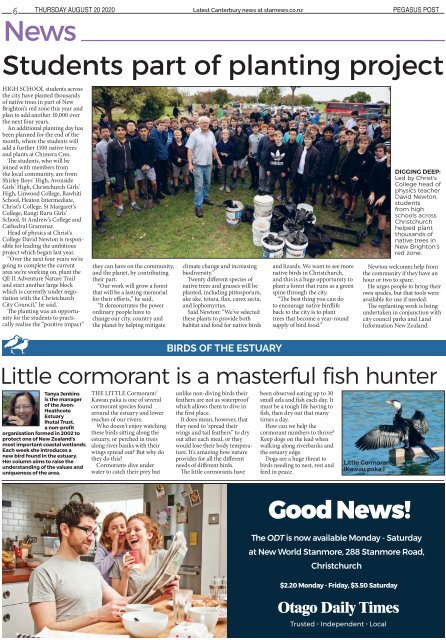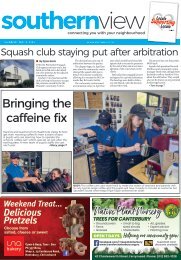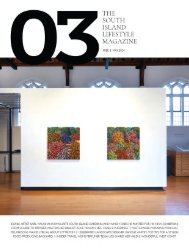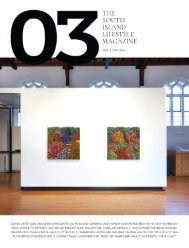Pegasus Post: August 20, 2020
Create successful ePaper yourself
Turn your PDF publications into a flip-book with our unique Google optimized e-Paper software.
6 Thursday <strong>August</strong> <strong>20</strong> <strong>20</strong><strong>20</strong><br />
Latest Canterbury news at starnews.co.nz<br />
PEGASUS POST<br />
News<br />
Students part of planting project<br />
HIGH SCHOOL students across<br />
the city have planted thousands<br />
of native trees in part of New<br />
Brighton’s red zone this year and<br />
plan to add another 10,000 over<br />
the next four years.<br />
An additional planting day has<br />
been planned for the end of the<br />
month, where the students will<br />
add a further 1100 native trees<br />
and plants at Chimera Cres.<br />
The students, who will be<br />
joined with members from<br />
the local community, are from<br />
Shirley Boys’ High, Avonside<br />
Girls’ High, Christchurch Girls’<br />
High, Linwood College, Rawhiti<br />
School, Heaton Intermediate,<br />
Christ’s College, St Margaret’s<br />
College, Rangi Ruru Girls’<br />
School, St Andrew’s College and<br />
Cathedral Grammar.<br />
Head of physics at Christ’s<br />
College David Newton is responsible<br />
for leading the ambitious<br />
project which began last year.<br />
“Over the next four years we’re<br />
going to complete the current<br />
area we’re working on, plant the<br />
QE II Adventure Nature Trail<br />
and start another large block<br />
which is currently under negotiation<br />
with the Christchurch<br />
City Council,” he said.<br />
The planting was an opportunity<br />
for the students to practically<br />
realise the “positive impact”<br />
they can have on the community,<br />
and the planet, by contributing<br />
their part.<br />
“Our work will grow a forest<br />
that will be a lasting memorial<br />
for their efforts,” he said.<br />
“It demonstrates the power<br />
ordinary people have to<br />
change our city, country and<br />
the planet by helping mitigate<br />
climate change and increasing<br />
biodiversity.”<br />
Twenty different species of<br />
native trees and grasses will be<br />
planted, including pittosporum,<br />
ake ake, totara, flax, carex secta,<br />
and lophomyrtus.<br />
Said Newton: “We’ve selected<br />
these plants to provide both<br />
habitat and food for native birds<br />
and lizards. We want to see more<br />
native birds in Christchurch,<br />
and this is a huge opportunity to<br />
plant a forest that runs as a green<br />
spine through the city.<br />
“The best thing you can do<br />
to encourage native birdlife<br />
back to the city is to plant<br />
trees that become a year-round<br />
supply of bird food.”<br />
DIGGING DEEP:<br />
Led by Christ’s<br />
College head of<br />
physics teacher<br />
David Newton,<br />
students<br />
from high<br />
schools across<br />
Christchurch<br />
helped plant<br />
thousands of<br />
native trees in<br />
New Brighton’s<br />
red zone.<br />
Newton welcomes help from<br />
the community if they have an<br />
hour or two to spare.<br />
He urges people to bring their<br />
own spades, but that tools were<br />
available for use if needed.<br />
The replanting work is being<br />
undertaken in conjunction with<br />
city council parks and Land<br />
Information New Zealand.<br />
Tanya Jenkins<br />
is the manager<br />
of the Avon-<br />
Heathcote<br />
Estuary<br />
Ihutai Trust,<br />
a non-profit<br />
organisation formed in <strong>20</strong>02 to<br />
protect one of New Zealand’s<br />
most important coastal wetlands.<br />
Each week she introduces a<br />
new bird found in the estuary.<br />
Her column aims to raise the<br />
understanding of the values and<br />
uniqueness of the area.<br />
THE LITTLE Cormorant/<br />
Kawau paka is one of several<br />
cormorant species found<br />
around the estuary and lower<br />
reaches of our rivers.<br />
Who doesn’t enjoy watching<br />
these birds sitting along the<br />
estuary, or perched in trees<br />
along river banks with their<br />
wings spread out? But why do<br />
they do this?<br />
Cormorants dive under<br />
water to catch their prey but<br />
BIRDS OF THE ESTUARY<br />
Little cormorant is a masterful fish hunter<br />
unlike non-diving birds their<br />
feathers are not as waterproof<br />
which allows them to dive in<br />
the first place.<br />
It does mean, however, that<br />
they need to ‘spread their<br />
wings and tail feathers” to dry<br />
out after each meal, or they<br />
would lose their body temperature.<br />
It’s amazing how nature<br />
provides for all the different<br />
needs of different birds.<br />
The little cormorants have<br />
been observed eating up to 30<br />
small eels and fish each day. It<br />
must be a tough life having to<br />
fish, then dry out that many<br />
times a day.<br />
How can we help the<br />
cormorant numbers to thrive?<br />
Keep dogs on the lead when<br />
walking along riverbanks and<br />
the estuary edge.<br />
Dogs are a huge threat to<br />
birds needing to nest, rest and<br />
feed in peace.<br />
Little Cormorant<br />
(Kawau paka )


















